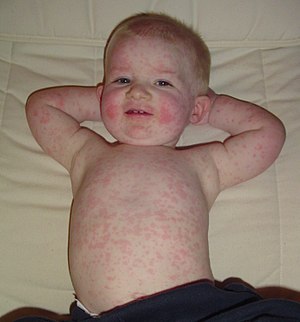Fifth disease
| Erythema infectiosum | |
|---|---|
 |
|
| 16-month-old with erythema infectiosum | |
| Classification and external resources | |
| Specialty | Infectious disease |
| ICD-10 | B08.3 |
| ICD-9-CM | 057.0 |
| DiseasesDB | 4442 |
| MedlinePlus | 000977 |
| eMedicine | emerg/378 derm/136 ped/192 |
| Patient UK | Fifth disease |
| MeSH | D016731 |
Erythema infectiosum or fifth disease is one of several possible manifestations of infection by parvovirus B19. The disease is also referred to as slapped cheek syndrome, slapcheek, slap face or slapped face.
The name "fifth disease" comes from its place on the standard list of rash-causing childhood diseases, which also includes measles (1st), scarlet fever (2nd), rubella (3rd), and Dukes' disease (4th), though the last is no longer widely accepted as distinct.
Fifth disease starts with a low-grade fever, headache, rash, and cold-like symptoms, such as a runny or stuffy nose. These symptoms pass, then a few days later the rash appears. The bright red rash most commonly appears in the face, particularly the cheeks. This is a defining symptom of the infection in children (hence the name "slapped cheek disease"). Occasionally the rash will extend over the bridge of the nose or around the mouth. In addition to red cheeks, children often develop a red, lacy rash on the rest of the body, with the upper arms, torso, and legs being the most common locations. The rash typically lasts a couple of days and may itch; some cases have been known to last for several weeks. Patients are usually no longer infectious once the rash has appeared.
Teenagers and adults may present with a self-limited arthritis. It manifests in painful swelling of the joints that feels similar to arthritis. Older children and adults with fifth disease may have difficulty in walking and in bending joints such as wrists, knees, ankles, fingers, and shoulders.
The disease is usually mild, but in certain risk groups it can have serious consequences:
Fifth disease is transmitted primarily by respiratory secretions (saliva, mucus, etc.) but can also be spread by contact with infected blood. The incubation period (the time between the initial infection and the onset of symptoms) is usually between 4 and 21 days. Individuals with fifth disease are most infectious before the onset of symptoms. Typically, school children, day-care workers, teachers and parents are most likely to be exposed to the virus. When symptoms are evident, there is little risk of transmission; therefore, symptomatic individuals don't need to be isolated.
...
Wikipedia
